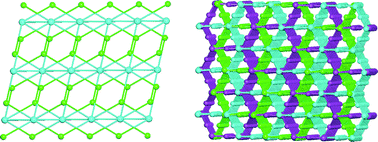Metal–organic frameworks based on 4-(4-carboxyphenyl)-2,2,4,4-terpyridine: structures, topologies and electrocatalytic behaviors in sodium laurylsulfonate aqueous solution†
Abstract
Using a novel rigid multitopic ligand, (4-(4-carboxyphenyl)-2,2,4,4-terpyridine) (HL), three novel metal–organic frameworks (MOFs) with formulae M2L2(1,4-bdc)(H2O) (1,4-H2bdc = 1,4-benzene dicarboxylic acid) (M = Co 1 and Ni 2) and Cu2L2(1,4-bdc)(H2O)·2H2O (3) have been solvothermally synthesized and structurally characterized by single-crystal X-ray diffraction. MOFs 1 and 2 are isostructural and feature a novel 2-nodal (3,8)-connected three-dimensional (3D) architecture with a (4·62)2(47·618·83) topology. MOF 3 comprises a novel 3-fold interpenetrated 3-nodal (3,4)-connected 3D framework with a (52·82·102) (52·8) (54·82) topology. MOFs 1–3 all show better solubilities in sodium laurylsulfonate (SDS) aqueous solution than in water. The three MOFs show different electrocatalytic behaviors for the H2 evolution reaction in SDS solution, and MOF 1 shows better electrocatalytic properties in higher concentrations of SDS aqueous solution.


 Please wait while we load your content...
Please wait while we load your content...